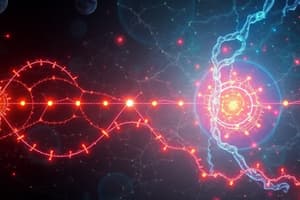Podcast
Questions and Answers
The process by which cells convert acetyl CoA to form ketone bodies is called ______.
The process by which cells convert acetyl CoA to form ketone bodies is called ______.
ketogenesis
[Blank] occurs in the liver cell.
[Blank] occurs in the liver cell.
Ketogenesis
3 molecules of acetyl CoA form 3-hydroxy-3-methylglutaryl (HMG-______).
3 molecules of acetyl CoA form 3-hydroxy-3-methylglutaryl (HMG-______).
CoA
Ketolysis occurs in an ______ cell.
Ketolysis occurs in an ______ cell.
From the liver, ketone bodies escape into the bloodstream and are transferred to an ______ cell.
From the liver, ketone bodies escape into the bloodstream and are transferred to an ______ cell.
Lactose intolerance is an inability to digest ______, a sugar found in milk.
Lactose intolerance is an inability to digest ______, a sugar found in milk.
Acetone, β-hydroxybutyrate, and acetoacetate are the three main ______ bodies.
Acetone, β-hydroxybutyrate, and acetoacetate are the three main ______ bodies.
All 3 main ketone bodies are made from ______ CoA.
All 3 main ketone bodies are made from ______ CoA.
Amino acids that can be converted to ketone bodies are called ______ amino acids.
Amino acids that can be converted to ketone bodies are called ______ amino acids.
When ketone bodies are broken down, it becomes ______.
When ketone bodies are broken down, it becomes ______.
Flashcards
Ketogenesis
Ketogenesis
The process by which cells convert acetyl CoA to form ketone bodies.
Where does ketogenesis take place?
Where does ketogenesis take place?
The process of forming ketone bodies occurs in the liver cells.
What is HMG-CoA made of?
What is HMG-CoA made of?
Three molecules of acetyl CoA combine to form a molecule called 3-hydroxy-3-methylglutaryl (HMG-CoA).
Where does ketolysis occur?
Where does ketolysis occur?
Signup and view all the flashcards
What happens to ketone bodies after they are made?
What happens to ketone bodies after they are made?
Signup and view all the flashcards
Lactose intolerance
Lactose intolerance
Signup and view all the flashcards
What are the three main ketone bodies?
What are the three main ketone bodies?
Signup and view all the flashcards
What is the starting material for ketone body production?
What is the starting material for ketone body production?
Signup and view all the flashcards
What are ketogenic amino acids?
What are ketogenic amino acids?
Signup and view all the flashcards
Ketolysis
Ketolysis
Signup and view all the flashcards
Study Notes
Lactose Intolerance
- Lactose intolerance is the inability to digest lactose, a sugar found in milk.
Ketogenesis and Ketolysis
- There are three main ketone bodies: acetone, β-hydroxybutyrate, and acetoacetate.
- All three main ketone bodies are formed from Acetyl CoA.
- Acetyl CoA can be transferred between cells.
- Ketogenic amino acids are amino acids that can be converted to ketone bodies.
Ketogenesis
- Ketogenesis occurs in liver cells.
- Three molecules of acetyl CoA form 3-hydroxy-3-methylglutaryl (HMG-CoA), which then forms acetoacetate and β-hydroxybutyrate (BtHB).
- Ketone bodies formed in the liver cell escape into the bloodstream and are transferred to extrahepatic cells.
Ketolysis
- Ketolysis occurs in extrahepatic cells.
- Ketone bodies are broken down in ketolysis to provide energy.
The Function of Ketone Bodies
- Cells with excess acetyl CoA can transfer it to cells with less acetyl CoA.
- Ketone bodies serve as an energy source for cells.
Studying That Suits You
Use AI to generate personalized quizzes and flashcards to suit your learning preferences.



